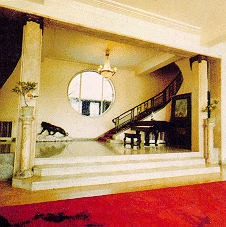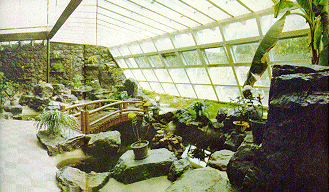 |
 |
 |
|
| |
|
|
 Garden
Houses Garden
Houses |
|
 |
Using
foreign architectural styles and constructed of new building
materials, Shanghai's garden houses, in appearance, might
well be classified into four styles: the classic; villa-like;
Spanish and modern style. The classic style came first.
Miniatures of grand palaces, these garden houses were
modeled on Renaissance architecture. A little later the
villa-like houses became popular. The greater part, landscaped
and situated off streets, look a little like English villas
with wooden trusses and steep roofs. Garden houses in
the Spanish style have gentle roofs, covered ways and
balconies. There are many of them in Shanghai, because
these house, with their beautifully-carved exteriors,
suit Shanghai's climate and are comparatively low in building
cost. Those in the modern style are unrestricted in layout
and very functional. The exterior, in harmony with the
interior, was modeled after international styles then
in vogue and the interior, with meticulously-decorated
walls, was well partitioned.
|
 The spiral
staircase in a garden house
The spiral
staircase in a garden house |
 A majestic-looking indoor stairway
A majestic-looking indoor stairway
|
Most of the
owners of garden houses were rich Chinese or foreign capitalists,
high-ranking government officials and VIPs. Their extravagance
and love of luxury can be seen in these buildings. The
garden house at No.333 Tongren Road, with a sun roof,
a canopied drive and a fan-like outdoor stairway leading
upstairs, was air-conditioned and equipped with a lift,
the first one ever installed in a Shanghai house. The
building at Shanxi Road formerly owned by an Englishman
is of Norwegian style. Built of firebricks, roofed with
glazed tiles from Qinhuangdao and with a special exterior,
the building, with its tower looks both exotic and stately.
In front of the building once stood a bronze horse, a
sign of luck for the Englishman, who made his fortune
at the horse races. |
|
|
|
| Most
of Shanghai's garden houses are still in good condition
owing to proper use and good care-taking by Shanghai's
municipal government and housing management departments.
They are standing reflections of the architectural development
and characteristics of metropolitan Shanghai at different
historical periods. |
|
|
|
 The indoor garden in Yao Mansion
(built in 1946),
The indoor garden in Yao Mansion
(built in 1946),
whose flat roof is capable of sliding open to let in
flowers |
|
|
|
|
|
|
|
 |
 |
 |
|
|
|
|
|
|
|


